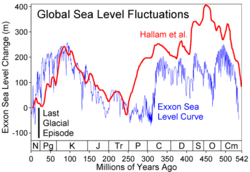
The sea-level curve (also known as the eustatic curve) is the representation of the changes of the sea level relative to present day mean sea level as gleaned from the stratigraphic record throughout the geological history.
The first such curve is the Vail curve or Exxon curve. The names of the curve refer to the fact that in 1977 a team of Exxon geologists from Esso Production Research headed by Peter Vail published a monograph[1] on seismic stratigraphic principles and global (eustati)) sea-level changes. Their sea-level curve was based on seismic and biostratigraphic data accumulated during petroleum exploration.[2]
The Vail curve (and the monograph itself) was the subject of debate among geologists, because it was based on undisclosed commercially confidential stratigraphic data, and hence not independently verifiable.[3] Because of this, there were later efforts to establish a sea-level curve based on non-commercial, public domain data from outcrops exposed on land and thus verifiable by other reserchers.
In 1987–1988 a revised eustatic sea-level curve for the Mesozoic and Cenozoic eras was published in Science magazine, now known as the Haq et al sea-level curve,[4] in reference to the marine geologist/oceanographer Bilal Haq[2]
Bilal Haq and Stephen Schutter later published the Paleozoic sea-level curve in 2008 also in Science. Subsequent revisions of the Mesozoic eustatic sea-level curve have been published by Haq for the Cretaceous, Jurassic, and Triassic, respectively in 2014, 2017, and 2018. Haq and his co-workers have now completed the sea-level history of the entire Phanerozoic Eon.
YouTube Encyclopedic
-
1/1Views:1 439
-
Rigveda To Robotics - HISTORICITY OF VEDIC and RAMAYAN ERAS
Transcription
References
- ^ PR Vail, RM Mitchum Jr, S Thompson III, 1977, Seismic Stratigraphy and Global Changes of Sea Level: Part 4. Global Cycles of Relative Changes of Sea Level.: Section 2. Application of Seismic Reflection Configuration to Stratigraphic Interpretation, AAPG Special Volumes 165, 83-97
- ^ a b Principles of Paleoclimatology, by Thomas M. Cronin (1999) ISBN 0-231-10955-5, pp. 381, 382
- ^ "Climate Change", William James Burroughs p 87
- ^ BU Haq, JAN Hardenbol, PR Vail, 1987, Chronology of fluctuating sea levels since the Triassic, Science 235 (4793), 1156-1167


